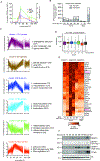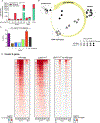Epigenetic Compensation Promotes Liver Regeneration
- PMID: 31231040
- PMCID: PMC6615735
- DOI: 10.1016/j.devcel.2019.05.034
Epigenetic Compensation Promotes Liver Regeneration
Abstract
Two major functions of the epigenome are to regulate gene expression and to suppress transposons. It is unclear how these functions are balanced during physiological challenges requiring tissue regeneration, where exquisite coordination of gene expression is essential. Transcriptomic analysis of seven time points following partial hepatectomy identified the epigenetic regulator UHRF1, which is essential for DNA methylation, as dynamically expressed during liver regeneration in mice. UHRF1 deletion in hepatocytes (Uhrf1HepKO) caused genome-wide DNA hypomethylation but, surprisingly, had no measurable effect on gene or transposon expression or liver homeostasis. Partial hepatectomy of Uhrf1HepKO livers resulted in early and sustained activation of proregenerative genes and enhanced liver regeneration. This was attributed to redistribution of H3K27me3 from promoters to transposons, effectively silencing them and, consequently, alleviating repression of liver regeneration genes, priming them for expression in Uhrf1HepKO livers. Thus, epigenetic compensation safeguards the genome against transposon activation, indirectly affecting gene regulation.
Keywords: DNA methylation; H3K27me3; UHRF1; epigenetic compensation; epigenomics; liver biology; partial hepatectomy; tissue regeneration; transposons.
Copyright © 2019 Elsevier Inc. All rights reserved.
Conflict of interest statement
Figures







Comment in
-
Repressive Epigenetic Signatures Safeguard the Liver.Dev Cell. 2019 Jul 1;50(1):3-4. doi: 10.1016/j.devcel.2019.06.006. Dev Cell. 2019. PMID: 31265811
-
Histone methylation boosts liver regeneration.Nat Rev Mol Cell Biol. 2019 Aug;20(8):454-455. doi: 10.1038/s41580-019-0157-8. Nat Rev Mol Cell Biol. 2019. PMID: 31273301 No abstract available.
References
-
- Akalin A, Franke V, Vlahovicek K, Mason CE, and Schubeler D (2015). genomation: a toolkit to summarize, annotate and visualize genomic intervals. Bioinformatics 31, 1127–1129. - PubMed
-
- Alonso A, Bernstein E, and Hasson D (2018). Histone native chromatin immunoprecipitation. in histone variants: methods and protocols, Orsi GA, and Almouzni G, eds. (Springer; New York: ), pp. 77–104. - PubMed
-
- Apte U, Gkretsi V, Bowen William C, Mars Wendy M, Luo JH, Donthamsetty S, Orr A, Monga Satdarshan PS, Wu C, and Michalopoulos George K (2009). Enhanced liver regeneration following changes induced by hepatocyteD specific genetic ablation of integrin□linked kinase. Hepatology 50, 844–851. - PMC - PubMed
Publication types
MeSH terms
Substances
Grants and funding
LinkOut - more resources
Full Text Sources
Molecular Biology Databases
Research Materials

